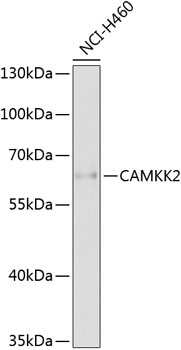Cell Biology Antibodies 12
Anti-CAMKK2 Antibody (CAB9899)
- SKU:
- CAB9899
- Product Type:
- Antibody
- Applications:
- WB
- Reactivity:
- Human
- Host Species:
- Rabbit
- Isotype:
- IgG
- Research Area:
- Cell Biology
Description
| Antibody Name: | Anti-CAMKK2 Antibody |
| Antibody SKU: | CAB9899 |
| Antibody Size: | 20uL, 50uL, 100uL |
| Application: | WB |
| Reactivity: | Human |
| Host Species: | Rabbit |
| Immunogen: | Recombinant fusion protein containing a sequence corresponding to amino acids 1-140 of human CAMKK2 (NP_757380.1). |
| Application: | WB |
| Recommended Dilution: | WB 1:500 - 1:2000 |
| Reactivity: | Human |
| Positive Samples: | NCI-H460 |
| Immunogen: | Recombinant fusion protein containing a sequence corresponding to amino acids 1-140 of human CAMKK2 (NP_757380.1). |
| Purification Method: | Affinity purification |
| Storage Buffer: | Store at -20'C. Avoid freeze / thaw cycles. Buffer: PBS with 0.02% sodium azide, 50% glycerol, pH7.3. |
| Isotype: | IgG |
| Sequence: | MSSC VSSQ PSSN RAAP QDEL GGRG SSSS ESQK PCEA LRGL SSLS IHLG MESF IVVT ECEP GCAV DLGL ARDR PLEA DGQE VPLD TSGS QARP HLSG RKLS LQER SQGG LAAG GSLD MNGR CICP SLPY SPVS SPQS SPRL |
| Gene ID: | 10645 |
| Uniprot: | Q96RR4 |
| Cellular Location: | Cell projection, Cytoplasm, Nucleus |
| Calculated MW: | 54kDa/58kDa/59kDa/61kDa/64kDa |
| Observed MW: | 65kDa |
| Synonyms: | CAMKK2, CAMKK, CAMKKB |
| Background: | The product of this gene belongs to the Serine/Threonine protein kinase family, and to the Ca(2+)/calmodulin-dependent protein kinase subfamily. The major isoform of this gene plays a role in the calcium/calmodulin-dependent (CaM) kinase cascade by phosphorylating the downstream kinases CaMK1 and CaMK4. Protein products of this gene also phosphorylate AMP-activated protein kinase (AMPK). This gene has its strongest expression in the brain and influences signalling cascades involved with learning and memory, neuronal differentiation and migration, neurite outgrowth, and synapse formation. Alternative splicing results in multiple transcript variants encoding distinct isoforms. The identified isoforms differ in their ability to undergo autophosphorylation and to phosphorylate downstream kinases. |
| UniProt Protein Function: | CAMKK2: Calcium/calmodulin-dependent protein kinase belonging to a proposed calcium-triggered signaling cascade involved in a number of cellular processes. Isoform 1, isoform 2 and isoform 3 phosphorylate CAMK1 and CAMK4. Isoform 3 phosphorylates CAMK1D. Isoform 4, isoform 5 and isoform 6 lacking part of the calmodulin- binding domain are inactive. Seems to be involved in hippocampal activation of CREB1. Belongs to the protein kinase superfamily. Ser/Thr protein kinase family. 7 isoforms of the human protein are produced by alternative splicing. |
| UniProt Protein Details: | Protein type:Autophagy; EC 2.7.11.17; Kinase, protein; Protein kinase, Other; Protein kinase, Ser/Thr (non-receptor); Other group; CAMKK family; Meta subfamily Chromosomal Location of Human Ortholog: 12q24.2 Cellular Component: cell projection; cytoplasm; intracellular; nucleus Molecular Function:calmodulin binding; calmodulin-dependent protein kinase activity; protein-tyrosine kinase activity; calcium ion binding; ATP binding Biological Process: peptidyl-tyrosine phosphorylation; positive regulation of transcription, DNA-dependent; protein amino acid autophosphorylation; calcium-mediated signaling; MAPKKK cascade; regulation of protein kinase activity; protein amino acid phosphorylation |
| NCBI Summary: | The product of this gene belongs to the Serine/Threonine protein kinase family, and to the Ca(2+)/calmodulin-dependent protein kinase subfamily. The major isoform of this gene plays a role in the calcium/calmodulin-dependent (CaM) kinase cascade by phosphorylating the downstream kinases CaMK1 and CaMK4. Protein products of this gene also phosphorylate AMP-activated protein kinase (AMPK). This gene has its strongest expression in the brain and influences signalling cascades involved with learning and memory, neuronal differentiation and migration, neurite outgrowth, and synapse formation. Alternative splicing results in multiple transcript variants encoding distinct isoforms. The identified isoforms differ in their ability to undergo autophosphorylation and to phosphorylate downstream kinases. [provided by RefSeq, Jul 2012] |
| UniProt Code: | Q96RR4 |
| NCBI GenInfo Identifier: | 317373374 |
| NCBI Gene ID: | 10645 |
| NCBI Accession: | Q96RR4.2 |
| UniProt Secondary Accession: | Q96RR4,O94883, Q8IUG2, Q8IUG3, Q8N3I4, Q8WY03, Q8WY04 Q8WY05, Q8WY06, Q96RP1, Q96RP2, A8K7Q7, |
| UniProt Related Accession: | Q96RR4 |
| Molecular Weight: | |
| NCBI Full Name: | Calcium/calmodulin-dependent protein kinase kinase 2 |
| NCBI Synonym Full Names: | calcium/calmodulin-dependent protein kinase kinase 2, beta |
| NCBI Official Symbol: | CAMKK2 |
| NCBI Official Synonym Symbols: | CAMKK; CAMKKB |
| NCBI Protein Information: | calcium/calmodulin-dependent protein kinase kinase 2; caM-KK 2; caM-KK beta; CAMKK beta protein; caM-kinase kinase 2; caM-kinase kinase beta; calcium/calmodulin-dependent protein kinase beta |
| UniProt Protein Name: | Calcium/calmodulin-dependent protein kinase kinase 2 |
| UniProt Synonym Protein Names: | Calcium/calmodulin-dependent protein kinase kinase beta; CaM-KK beta; CaM-kinase kinase beta; CaMKK beta |
| Protein Family: | Calcium/calmodulin-dependent protein kinase |
| UniProt Gene Name: | CAMKK2 |
| UniProt Entry Name: | KKCC2_HUMAN |
View AllClose







